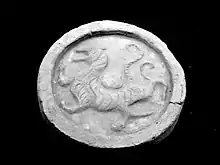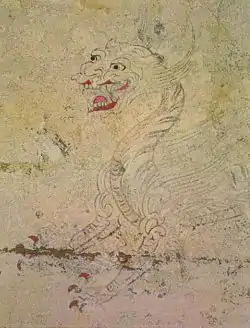| White Tiger | |||||||||||||||||
|---|---|---|---|---|---|---|---|---|---|---|---|---|---|---|---|---|---|
 Bái Hǔ sculpture on an eaves tile | |||||||||||||||||
| Chinese name | |||||||||||||||||
| Chinese | 白虎 | ||||||||||||||||
| |||||||||||||||||
| Korean name | |||||||||||||||||
| Hangul | 백호 | ||||||||||||||||
| Hanja | 白虎 | ||||||||||||||||
| |||||||||||||||||
The White Tiger (Chinese: 白虎; pinyin: Báihǔ), known in Chinese as Baihu, is one of the Four Symbols of the Chinese constellations. It is sometimes called the White Tiger of the West (西方白虎; Xīfāng Báihǔ). It represents the west in terms of direction and the autumn season.

Seven Mansions
As with the other three Symbols, there are seven astrological "Mansions" (positions of the Moon) within the White Tiger. The names and determinative stars are:[1][2]
| Mansion no. | Name (pinyin) | Translation | Determinative star |
|---|---|---|---|
| 15 | 奎 (Kuí) | Legs | Eta Andromedae |
| 16 | 婁 (Lóu) | Bond | Beta Arietis |
| 17 | 胃 (Wèi) | Stomach | 35 Arietis |
| 18 | 昴 (Mǎo) | Hairy Head | Alcyone |
| 19 | 畢 (Bì) | Net | Ain |
| 20 | 觜 (Zī) | Turtle Beak | Meissa |
| 21 | 參 (Shēn) | Three Stars | Alnitak |
See also
References
- ↑ "The Chinese Sky". International Dunhuang Project. Archived from the original on 2015-11-04. Retrieved 2011-06-25.
- ↑ Sun, Xiaochun (1997). Helaine Selin (ed.). Encyclopaedia of the History of Science, Technology, and Medicine in Non-Western Cultures. Kluwer Academic Publishers. p. 517. ISBN 0-7923-4066-3. Retrieved 2011-06-25.
This article is issued from Wikipedia. The text is licensed under Creative Commons - Attribution - Sharealike. Additional terms may apply for the media files.